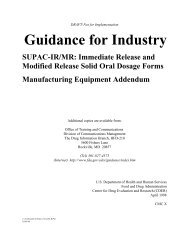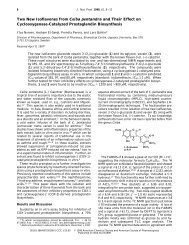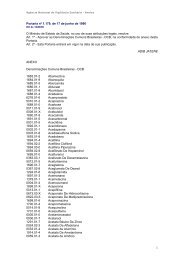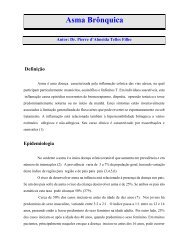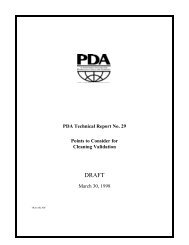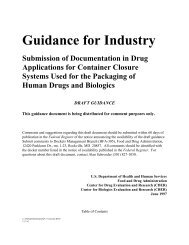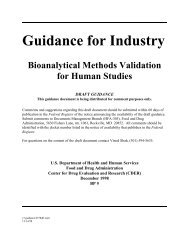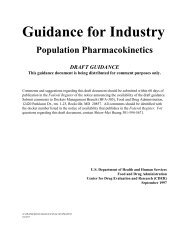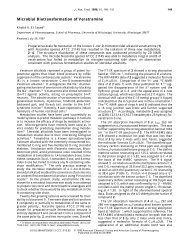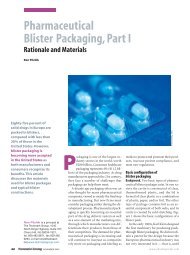ANDAs impurities in drug substances - Pharmanet
ANDAs impurities in drug substances - Pharmanet
ANDAs impurities in drug substances - Pharmanet
- No tags were found...
You also want an ePaper? Increase the reach of your titles
YUMPU automatically turns print PDFs into web optimized ePapers that Google loves.
Draft-Not for Implementation7778798081828384858687888990919293949596979899100101102103104105106107108109110111the impurity profile of the <strong>drug</strong> substance, and possible degradation products. Thisdiscussion may <strong>in</strong>clude only those <strong>impurities</strong> that may reasonably be expected based onknowledge of the chemical reactions and conditions <strong>in</strong>volved.In addition, the DMF holder or the ANDA applicant should summarize the laboratorystudies conducted to detect <strong>impurities</strong> <strong>in</strong> the <strong>drug</strong> substance. This summary should<strong>in</strong>clude test results of materials manufactured dur<strong>in</strong>g the development process and batchesfrom the proposed commercial process, as well as results of <strong>in</strong>tentional degradationstudies used to identify potential <strong>impurities</strong> that arise dur<strong>in</strong>g storage. Assessment of theproposed commercial process may be deferred until the first batch is produced formarket<strong>in</strong>g. The impurity profile of the <strong>drug</strong> substance lots <strong>in</strong>tended for market<strong>in</strong>g shouldbe compared with those used <strong>in</strong> development and any differences discussed.The studies (e.g., NMR, IR, and MS) conducted to characterize the structure of actual<strong>impurities</strong> present <strong>in</strong> the <strong>drug</strong> substance at or above an apparent level of 0.1 percent (e.g.,calculated us<strong>in</strong>g the response factor of the <strong>drug</strong> substance) should be described. Note thatall recurr<strong>in</strong>g <strong>impurities</strong> at or above an apparent level of 0.1 percent (see section IV) <strong>in</strong>batches manufactured by the proposed commercial process should be identified.Degradation products observed <strong>in</strong> stability studies at recommended storage conditionsshould be similarly identified. When identification of an impurity is not feasible, asummary of the laboratory studies demonstrat<strong>in</strong>g the unsuccessful effort should be<strong>in</strong>cluded <strong>in</strong> the DMF or application. Where attempts have been made to identify <strong>impurities</strong>below the 0.1 percent level, it is useful to also report the results of these studies.Identification of <strong>impurities</strong> below apparent levels of 0.1 percent is generally not considerednecessary. However, identification should be attempted for those potential <strong>impurities</strong> thatare expected to be unusually potent, produc<strong>in</strong>g toxic or pharmacologic effects at a levellower than 0.1 percent. In all cases, <strong>impurities</strong> should be qualified as described later <strong>in</strong> thisguidance. Although it is common practice to round analytical results of between 0.05 and0.09 percent to the nearest number (i.e., 0.1 percent), for the purpose of this guidance,such values should not be rounded to 0.1 percent <strong>in</strong> determ<strong>in</strong><strong>in</strong>g whether to identify the<strong>impurities</strong>.B. Inorganic ImpuritiesInorganic <strong>impurities</strong> are normally detected and quantitated us<strong>in</strong>g pharmacopoeial or otherappropriate procedures. Carry-over of catalysts to the <strong>drug</strong> substance should be evaluateddur<strong>in</strong>g development. The need for <strong>in</strong>clusion or exclusion of <strong>in</strong>organic <strong>impurities</strong> <strong>in</strong> the<strong>drug</strong> substance specifications should be discussed. Acceptance criteria should be based onpharmacopeial standards or known safety data.J:\!GUIDANC\2452DFT.WPDJuly 21, 19984



